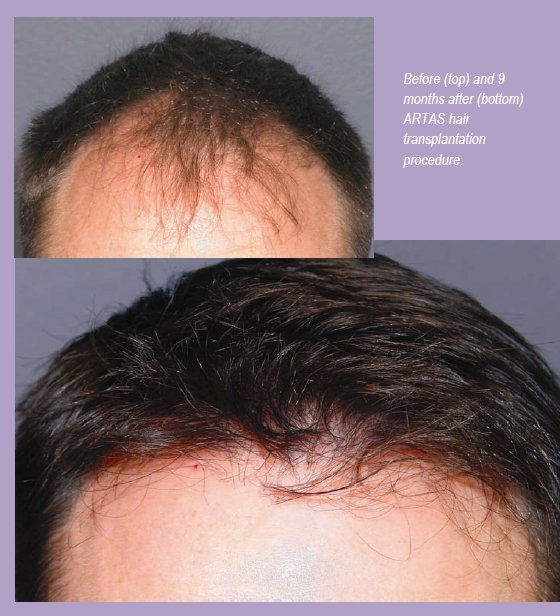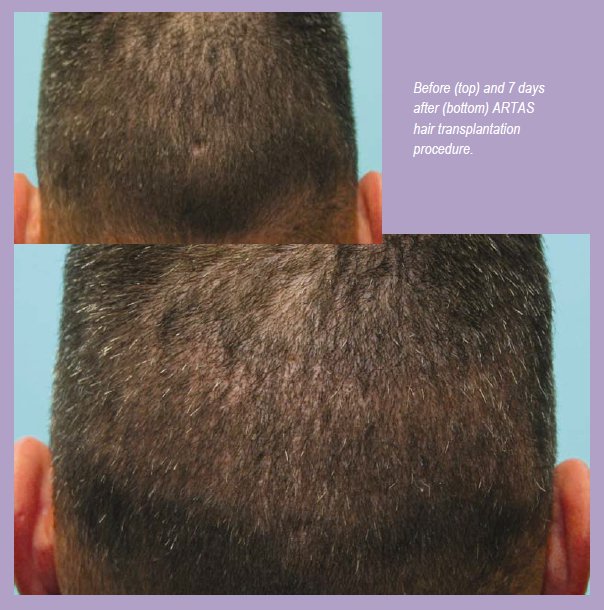Robotics in FUE hair transplant surgery is a topic that is attracting increasing attention in the world of hair restoration. As we have discussed, the ARTAS robotic system for hair restoration is the newest technology in this ever-evolving field.
This new system, developed by Restoration Robotics, Inc., is more than just a new tool for performing Follicular Unit Extraction. Rather, it is a complex system that uses the latest in mechanical and software technology to automate FUE surgery. The robot not only allows doctors to perform this typically labor and skill intensive procedure, but it provides a variety of benefits to their patients. Among these benefits are increased accuracy in follicular unit graft harvesting, reduced harvesting time, and increased graft survival.
An article in the September/October 2011 issue of the journal Aesthetic Trends & Technologies adds detail to our knowledge of the benefits of the ARTAS System. The article, titled, “How Technology is Changing the Hair Restoration Industry,” first gives a basic overview of the system and why it was developed. It then goes on to describe how a specially-designed device, called a skin tensioner, along with an image-guided system, tracks each follicular unit on the patient’s scalp and allows for the precise control of graft extraction.
From the article:
The technology determines the location, angle, and direction of each individual hair follicle; and via complex algorithms and computer programming, it is able to determine almost instantaneously the proper approach to harvest each follicular unit. The image-guided robotic arm begins harvesting the hair follicles in random patterns, according to the harvest spacing set by the physician. These random patterns make the procedure virtually undetectable after the wounds have healed.
The accuracy and performance of the image-guided robotic system is notable and contributes significantly to the improved outcome of the FUE procedure. As Miguel Canales, M.D., Medical Director for Restoration Robotics, says in the article, the transection rate, or rate at which follicular units are damaged in the extraction process, is consistently less with robotic controlled FUE compared to that performed manually.
This kind of consistency yields a benefit not only to seasoned hair restoration surgeons, but to physicians of all skill levels. James Harris, M.D., a hair restoration physician based in Colorado, says that a novice physician, who might only be able extract 50-70 grafts in one hour using the traditional manual technique, extract 600-700 an hour. For a procedure of 1,500 grafts, the physical demand on both the physician and the patient is substantially reduced with the ARTAS System versus the standard manual graft excision techniques in FUE surgery.
The developers of the ARTAS System were also conscientious of the safety of the FUE patient. An array of sensors monitors patient movement and causes the system to respond to the force of the punch used in graft excision or to any instances where the system’s casing touches the patient. If the force exerted is too strong, or if the casing touches the patient, the system automatically backs away from the patient, allowing the physician to make sure that all is well before the surgery proceeds. According to the article, there were no safety-related “adverse events” in trials with over 350 patients.
From the efficiency of the ARTAS System in extracting follicular unit grafts, to the quality of the grafts, to patient safety, the benefits are many for the physician. The patient will receive a high quality hair transplant with a less intensive time commitment, less local anesthesia needed to numb the area, improved hair growth rates, and a better overall FUE hair transplant experience.






